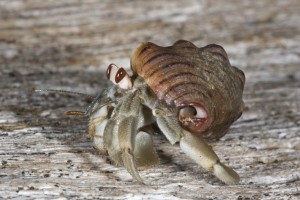We're open daily! View holiday hours
Science News
Beware of Social Hermit Crabs
November 5, 2012

When are solitary creatures social? When they’re looking for a new home. Or at least that’s what a UC Berkeley researcher has found for terrestrial hermit crabs.
Most of the 800-plus species of hermit crabs live in the ocean and reside in easily-found discarded snail shells. But the dozen or so species of land-based hermit crabs—like the ones you may have kept as a pet as a kid—have a tougher time finding a home.
Empty shells are common in the ocean because of the prevalence of predators like shell-crushing crabs with wrench-like pincers, snail-eating puffer fish, and stomatopods, which have the fastest and most destructive punch of any predator.
On land, however, the only shells available come from marine snails tossed ashore by waves. With limited availability, land-based hermit crabs, unlike their under-the-sea brethren, hollow out and remodel their shells, sometimes doubling the internal volume. This provides more room to grow, more room for eggs—sometimes a thousand more eggs—and a lighter home to lug around as they forage.
But that can involve a lot of work. So when the hermit crabs need even bigger shells, they socialize, according to Mark Laidre, a UC Berkeley postdoc who reports this unusual behavior in the current issue of Current Biology.
Laidre watched the hermit crab species Coenobita compressu on the Pacific shore of Costa Rica, where the crabs are found by the millions along tropical beaches. He tethered individual crabs, the largest about three inches long, to a post and monitored the free-for-all that typically appeared within 10-15 minutes.
He discovered that when three or more terrestrial hermit crabs congregate, they quickly attract dozens of others eager to trade up. They typically form a conga line, smallest to largest, each holding onto the crab in front of it, and, once a hapless crab is wrenched from its shell, simultaneously move into larger shells.
It’s almost certain death for the crab who loses this musical shells game. “The one that gets yanked out of its shell is often left with the smallest shell, which it can’t really protect itself with,” says Laidre. “Then it’s liable to be eaten by anything. For hermit crabs, it’s really their sociality that drives predation.”
Laidre says the crabs’ unusual behavior is a rare example of how evolving to take advantage of a specialized niche—in this case, land versus ocean—led to an unexpected byproduct: socialization in a typically solitary animal. But socialization with potentially dangerous consequences…
So when does a children’s game turn lethal? When it’s played by Coenobita compressu.
Image: Mark Laidre, UC Berkeley